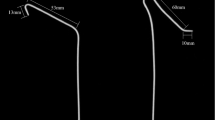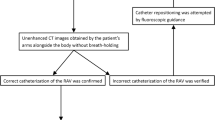Abstract
Purpose
To evaluate the importance of selecting an appropriate catheter shape for the right adrenal vein (RAV) anatomy on CT to the success of right adrenal venous sampling (RAVS) by elucidating the interactions of anatomical factors with catheter shape.
Materials and methods
130 patients with enhanced CT underwent RAVS using two catheters: catheter 1 was planar and catheter 2 was a three-dimensional shape. The following anatomical factors on CT were evaluated in each patient: presence of a right adrenal tumor, presence of a common trunk with an accessory right hepatic vein, diameter of the RAV, short and long diameters of the IVC, ratio of the long to the short diameter of IVC, and the transverse, modified transverse, and vertical angles of the RAV. RAVs were classified by direction on CT as lateral–caudal, lateral–cranial, medial–caudal, or medial–cranial. The technical feasibility of each catheter was evaluated by intragroup analysis.
Results
108 patients underwent technically successful RAVS with one or both catheters. Eight of the 22 patients in whom RAVS was not successfully achieved by either catheter within ten minutes required microcatheters; other catheters were used in the other 14. The factors that were found to be associated with RAVS success were the modified transverse and the vertical angles (p < 0.01) of RAV on CT. Catheters 1 and 2 provided stable sampling in the lateral–caudal and medial groups, respectively.
Conclusion
Adapting the shape of the catheter to the anatomy of the RAV can make RAVS more feasible. The anatomical factors that were found to be associated with RAVS success were the transverse angle modified by the IVC axis as well as the vertical angle of RAV on CT.






Similar content being viewed by others
References
Doppman JL, Gill JR Jr. Hyperaldpsteronism: sampling the adrenal veins. Radiology. 1996;198:309–12.
Rossi GP, Sacchetto A, Chiesura-Corona M, De Toni R, Gallina M, Feltrin GP, Pessina AC, et al. Identification of the etiology of primary aldosteronism with adrenal vein sampling in patients with equivocal computed tomography and magnetic resonance findings: results in 104 consecutive cases. J Clin Endocrinol Metab. 2001;86:1083–90.
Young WF, Stanson AW. What are the keys to successful adrenal venous sampling (AVS) in patients with primary aldosteronism? Clin Endocrinol. 2009;70:14–7.
Georgiades CS, Hong K, Geschwind JF, et al. Adjunctive use of C-Arm CT may eliminate technical failure in adrenal vein sampling. J Vasc Interv Radiol. 2007;18:1102–5.
Gagnon R. The venous drainage of the human adrenal gland. Rev Can Biol. 1956;14:350–9.
Johnstone FRC. The suprarenal veins. Am J Surg. 1957;94:615.
Mikaelsson CG. Venous communications of the adrenal glands. Anatomic and circulatory studies. Acta Radiol Diagn. 1970;10:369.
Monkhouse WS, et al. The adrenal and renal veins of man and their connections with azygos and lumbar veins. J Anat. 1986;146:105–15.
Matsuura T, Takase K, et al. Radiological anatomy of the right adrenal vein: preliminary experience with multidetector-row computed tomography. AJR. 2008;191:402–8.
Doppman JL, Gill JR Jr. Hyperaldosteronism: sampling the adrenal veins. Radiology. 1996;198:309–12.
Daunt N. Adrenal vein sampling: how to make it quick, easy, and successful. Radiographics. 2005;25:S143–58.
Harper R, Ferrett CG, McIlrath EM, Russell CF, Sheridan B, Atkinson AB. Accuracy of CT scanning and adrenal vein sampling in the pre-operative localization of aldosterone-secreting adrenal adenomas. Oxf J Med. 1999;92:643–50.
Araki T, Okada H, Araki T. Abdominal pressing maneuver during adrenal venous sampling for stabilization of catheter position. CVIR. 2014;37:498–501.
Nishikawa T, Omura M, Satoh F, Shibata H, Takahashi K, Tamura N, Tanabe A. Task force committee on primary aldosteronism. The Japan Endocrine Society guidelines for the diagnosis and treatment of primary aldosteronism—the Japan Endocrine Society 2009. Endocr J. 2011;58:711–21.
Galat SJ, Hopkins SM, Cheesman KC, Zhuk RA, Levine AC. Primary aldosteronism: emerging trends. Trends Endocrinol Metab. 2013;24:421–30.
Onozawa S, Yamaguchi H, Murata S, et al. Present status and strict analysis of adrenal venous sampling. Jpn J Intervent Radiol. 2015;30:42–7.
Author information
Authors and Affiliations
Corresponding author
Ethics declarations
Conflict of interest
There is no conflict of interest.
About this article
Cite this article
Araki, T., Okada, H. & Onishi, H. Does catheter shape influence the success of right adrenal venous sampling? The interaction of catheter shape to anatomical factors on CT. Jpn J Radiol 34, 707–717 (2016). https://doi.org/10.1007/s11604-016-0571-1
Received:
Accepted:
Published:
Issue Date:
DOI: https://doi.org/10.1007/s11604-016-0571-1




